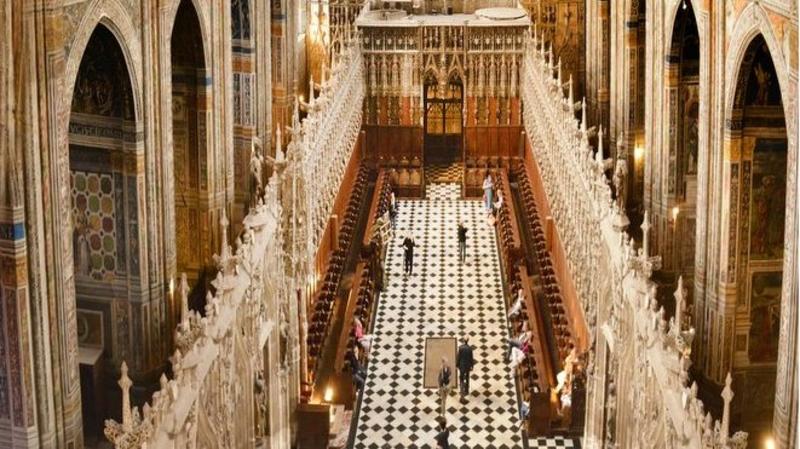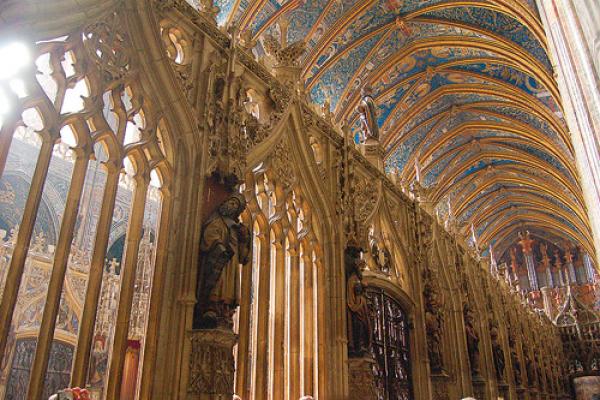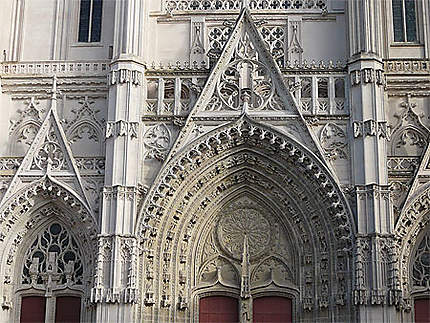TOULOUSE & AREA
This sunny corner of SW France is known for its food and wine, but it also has great art.
I had an imposing day today (Mar 18): 2 Unesco sites, 2 wonderful cities to visit, and 9 Nomad Mania ticks. I even threw in 3 churches. When one has their own vehicle and drives to see everything, a lot can be accomplished.
I started driving early to find the Canal du Midi, a formidable feat of 17th-century engineering. My driver assistant abandoned me and I turned off the interstate to find Revel and its museum on the canal. It was a long way and all signs for the museum disappeared. I pushed on but had no luck. My very first plan had been to go to Albi but it was too far out of the way – but now I was almost there. That is what vagabonding is all about – you can change plans on the fly.
ALBI (pop50,000). NE of Toulouse, Albi has two claims to fame – a truly mighty cathedral and Toulouse-Lautrec. It also has a memorable old town, virtually empty when I walked through.
Cathedral St Cécile. This massive brick edifice looks more like a castle. Begun in 1282, it took more than a century to complete, and now 8 centuries later, it’s one of the world’s largest brick buildings. It was Unesco listed in 2010.
Cathedrals here are very long and narrow and the interior of this one was as grand as the outside. All the chapels and walls were painted in interesting geometric designs accenting all the spectacular stucco work, especially around the choir. On Sundays, the choir (5€) was closed for mass when I arrived and I could only get glances at the checkerboard floor and more stucco carvings.
Musée Toulouse Lautrec. Inside the Palais de la Berbie, this museum holds 1000 of Albi’s favourite son’s art. He is most known for his famous Parisian brothel scenes, dancers, and poster art.
TOULOUSE (pop 459,000)
Ochre rooftops and red brickwork have given Toulouse its nickname – the pink city. Its gorgeous old town sprawls into France’s fourth-largest metropolis. Sitting between the Garonne River and Canal du Midi, it is known for its waterways. With one of France’s largest universities, it is also home to the European aeronautical giant Airbus, just 10kms NW of the city.
Place du Capitole. This magnificent main square is surrounded by pavement cafes backed by the 128m-long city hall containing the prestigious opera house. To the south is the old Quarter, a tangle of lanes and squares.
Basilique St-Sermin. This Romanesque church has rose-hued stonework and an octagonal bell tower. It is named for Toulouse’s first bishop, martyred after pagan priests tied him to a bull. 5€ is charged for the ambulatory and crypt.
Musée St-Raymond. Holding Roman ruins, a mosaic, Greek art, and a crypt, this is one museum I would have skipped in retrospect. One can only see so much of this stuff. 4€
Musée des Augustins. This fine art museum spans from the Roman era to the early 20th century. The showpiece is the building, a former Augustinian monastery with grand rib vaulted ceilings. The galleries come off the cloister and one is the church, with a fine exhibit of Renaissance art centering on Toulouse. 6€
Foundation Bemberg. I get tired of Museums, but not this one. Housed in Toulouse’s most impressive hôtel particulier (private mansion), the Hôtel d’ Assezat, the several themed rooms are packed with art, period furniture, clocks, small bronzes, candlesticks, pottery, and everything you expect in a mansion. The eclectic variety keeps one’s interest high. Upstairs are several Picassos and Toulouse Lautrec. 8€
Cathedral de St-Etienne. The city’s cathedral dates from the 12-13th century. It has a wonderful rose window, spectacular stained glass, and some of the best wood carving in the choir seats – everyone is different – and for once, you can walk beside them all.
Toulouse Metro. On the Nomad Mania list, I finished my day by touring part of the subway system. For one fare, you can see all of the 2-line systems. I’m not sure why it is on the NM list as it has no art and every station is the same modern, white tile and stainless steel. It is fast, quiet and very efficient.
Airbus Factory Tours. I didn’t go to this as bookings must be made 2 days before online to the 700-hectare factory – www.manatour.fr.
CANAL DU MIDI. This mother of France’s canals, it stretches 242 km from Toulouse to the southern port of Sète, connecting the Atlantic and the Mediterranean. Built under Louis XIV to support the Languedoc wine and wheat trade and to bypass the pirate-ridden transport routes around Spain, it was completed in 1681. The engineering mastermind, Pierre Paul Riquet devised a system of dams, bridges, aqueducts, tunnels, and locks to overcome the difficult terrain. It took years for the 12,000 workers to complete the debt-ridden project.
Its commercial importance was eclipsed by the railway in the 19th century, but it is now very popular with pleasure boaters, taking several weeks to navigate it all. The most scenic stretches are near Agde, Beziers, and Narbonne. A bike route follows the old towpaths and cruises can be hired.
It is Unesco-listed.
ATLANTIQUE
I woke up at 4:30 and decided to take a short detour to see the Dune du Pilat, the highest dune in Europe. My goal was to eat breakfast at sunrise parked beside the dune. My drive assistant took me to a shabby suburb in Bordeaux and corrected me when I entered Great Dune du Pilat!
DUNE DU PILAT. On an ugly, cold, rainy day, the detour turned out to be 70 km each way. With some slow-mo traffic, I finally arrived and foolishly entered the pay parking lot. It was easy to understand why I was the only one there. I struggled up the deep sand to the top of the dune in driving rain, only inverting my umbrella once. The views from the top were extraordinary. Although the dune is not that high, it stretches for a few kilometres along the coast in one continuous crest. Views were out to the many sandbanks, and well-known bird sanctuaries. The dune system is surrounded by a mature coastal pine forest. A highlight was seeing a pair of pheasants – bright red face, green head and neck, white band around the neck and a big mid-brown body (the male had greenish feathers at the back) and a long tail. I saw them coming and going.
Hating to pay for parking, I kicked out a small wood post, lifted the 6-foot post out of the ground negotiated through the small opening, and bypassed the gate
BORDEAUX (pop 243,000). This city is one of France’s most exciting with half the city (18 sq. km) Unesco listed, making it the world’s largest urban World Heritage Site (Port of the Moon). Many boulevards are pedestrianized. With a large university population and its world-renowned wines, it gets 3.5 million visitors a year.
The day I visited was truly horrendous – cold and windy with driving rain. Surprisingly I immediately found a parking spot on the river and walked the big promenade along the river to the Mirror d’Eau, the world’s largest reflecting pool covering 3450 sq meters of black granite. Its thin slick of water is drained and refilled every half hour and a dense fog-like vapor is ejected for 3 minutes every 23 minutes in the summer. On the day I visited, it was much less dramatic. The only people out and about were 2 mad joggers. I then entered the old town where there were more people. It was a Monday when most museums are closed, but I have had my fill of museums. a
Cathedral St-André. Its oldest sections date from 1096. On Mondays, it didn’t open till 2 pm, so I only saw the outside. The north portal has good masonry carvings but the most striking aspect of the church is its 50m high gargoyled Gothic belfry erected between 1440 and 1466.
ST-ÉMILLION (pop 1900). 40kms east of Bourdeaux, this medieval village is the most alluring of all the region’s wine towns. Named after Emillion, a miracle-working Benedictine monk who lived in a cave here between 750 and 767, it soon became a stop on pilgrimage routes and the town and vineyards are Unesco-listed. Pass continuous vineyards and wine producers on the way here. The main streets are lined with honey-coloured stores and cellars selling wine. It is easy to walk almost everywhere in about an hour.
Clocher de l’Eglice Monolithe. This is the first thing you notice with its spiking Gothic bell tower. It is closed to all but guided tours. Inside are 196 steps.
Tour du Roy. This sturdy square tower has 128 steps to the top and gives good views down to the Dordogne River and its bucolic valley.
Cordeliers Cloister. This stunning Romanesque church is the only open thing to see. Long and narrow, it has marvellous ribbed domes and roof lines. All the effigies were draped in brown cloth that looked like a monk’s habit.
I walked on the deck of the Hotelier de Plaisance for great views down to the lower part of the town and had a look at their price list. Rooms were 455-730€ per night. The Michelin-rated restaurant was equally priced out of my market: starters were 65-85€, mains 135-185€, and desserts 21-28€.
On the way to La Rochelle north of Bordeaux along the ocean, I drove through the most amazing blizzard with driving snow. Cars were moving at a snail’s pace and there were a few accidents. I eventually drove through it but temperatures were barely above freezing.
I passed several sites that I would have liked to visit on a nicer day.
Cordouan Lighthouse. On a rock 7 km out to sea, at 68m high, it is the tallest lighthouse in Europe. The inside is beautifully decorated. Access from Royan, on the north shore of the mouth of the Garonne River.
Fort Boyard. This is a 20m high fortress island midway between the Ile d’Aux and Ile d’Oléron just south of La Rochelle. It was dreamt up in the 1700s to defend the Bay of Rochefort against the English, but construction didn’t begin until a century later when then took 62 years to complete. It never was used as a fort but first served as a prison for Prussian soldiers and then abandoned. In 1990, it became the TV studio and film location for the French game show Fort Boyard but is closed to the public. It is best seen from a boat or kayak accessed from Fouras, 30 km south of La Rochelle.
LA ROCHELLE (pop 78,000)
Known as the “White City” for its limestone facades, it was one of France’s foremost seaports from the 14th to the 17th centuries. The early French settlers of Canada, including the founders of Montreal, set sail from here in the 17th century.
The Vieux Port (old port) is gorgeous. First, pass a marina with thousands of sailboats with masts. The buildings are striking white. At the old port are 3 stone towers with crenellated bastions. One has a witch’s hat tower. I walked all over enjoying the marvellous views.
ILE de RE. This 30km long (5kms at its widest) island is linked by a toll bridge from La Rochelle. In the summer it is mobbed by tourists. St-Matin-de-Re is the main town and a fishing port surrounded by a star-shaped fortification and a citadel. Walk up the 257 steps of Phare des Baleines, the island’s red-tipped lighthouse for panoramic views.
NANTES (pop 293,000)
History. Nantes was founded by Celts around 70 BC and in 937 AD, it joined the Duchy of Brittany. The Edict of Nantes, a landmark royal charter guaranteeing civil rights to France’s Huguenots (Protestants) was signed in Nantes by Henri IV in 1398. By the 18th century, Nantes was France’s foremost port, and in the 19th century, following the abolition of slavery, it became an industrial center. The world’s first public transport service, the omnibus, began here in 1826. Shipbuilding anchored the city’s economy until the late 20th century and when the shipyards relocated westwards to St-Nazaire, Nantes transformed itself into a thriving student and cultural hub.
Cathedrale St-Pierre et St-Paul. Although I get tired of churches, this one was great. Built of white limestone and with gorgeous higher and lower stained glass windows, it was bright and airy. Each chapel had an explanation of who was there and most statues of the saints were labeled. The highlight is the tomb of Francois II, Duke of Brittany, and his second wife, Marguerite de Foix, a masterpiece of Renaissance art. Statues of the four virtues are on each corner and the sides have the 12 apostles. The stained glass is a wonderful abstract, forever timeless.
Chateau des Ducs du Bretagne. This Castle of the Dukes of Brittany details the city’s history, including its role in the slave trade. The castle is surrounded by a moat and the ramparts give nice explanations of the views comparing the old view when the Loire River ran next to the castle but has been relocated south.









